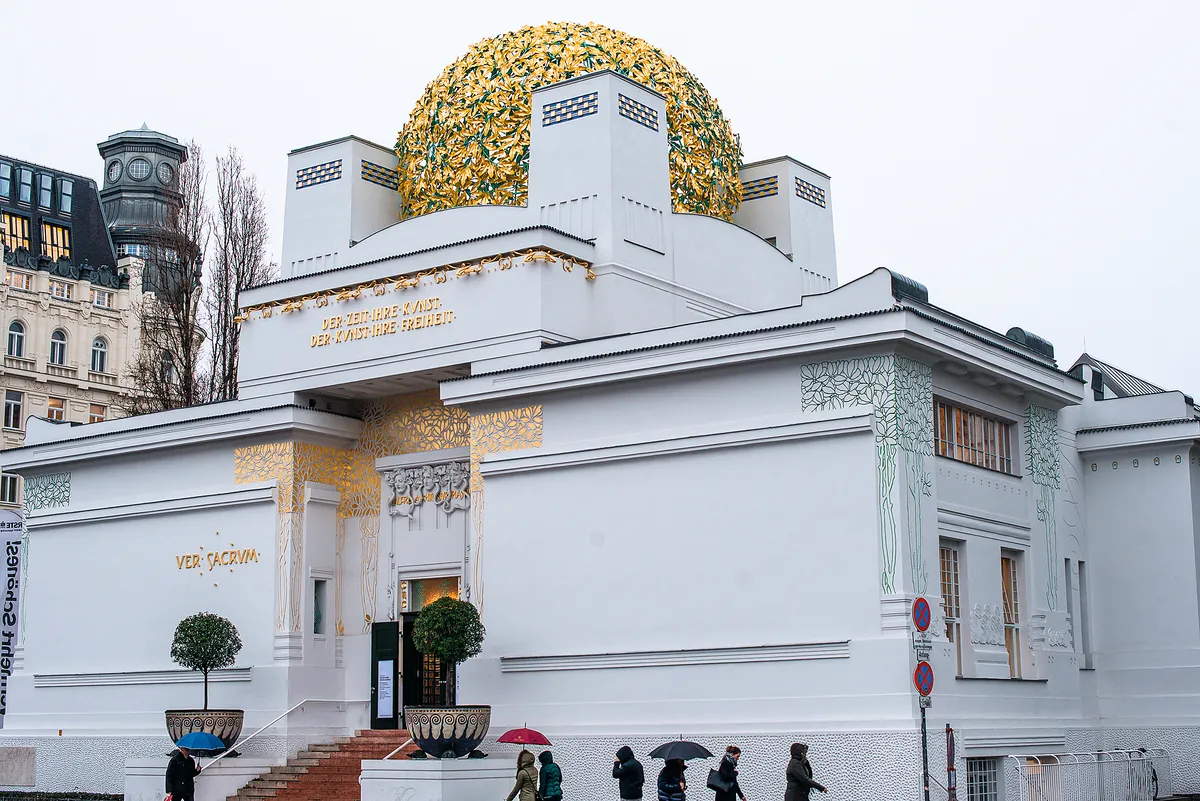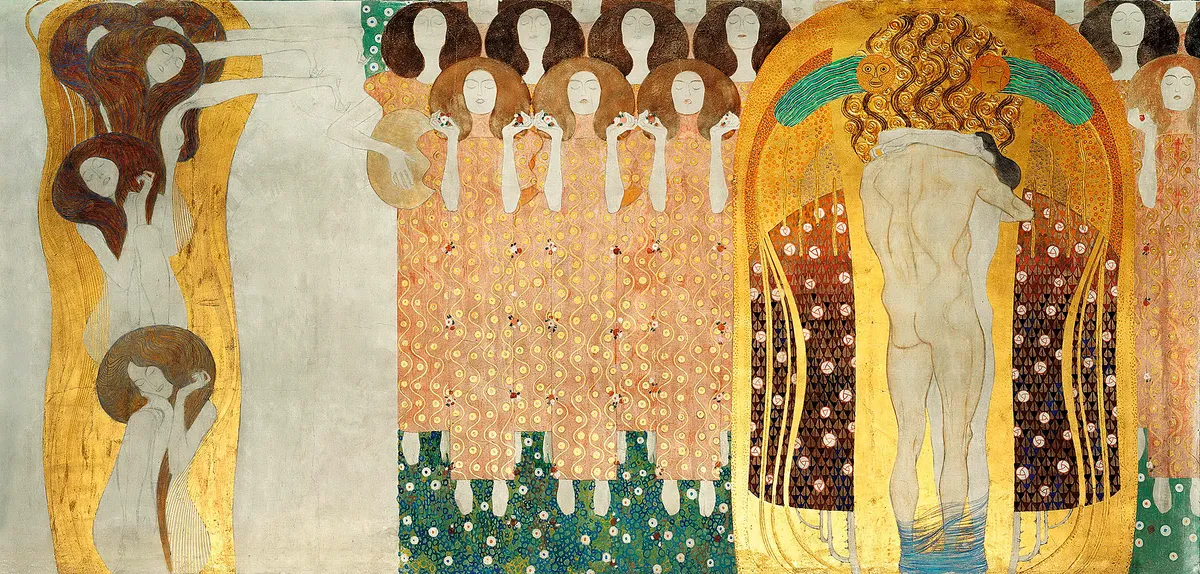Back in 1902, a group of artists in the composer’s adopted city planned a homage to Beethoven like no other: an ambitious fusion of art and design, sculpture and architecture, probing the notion of the composer’s role – and that of any artist – as a moral force.
True, the Ninth Symphony was a catalyst, even briefly (if enduringly) implicating Gustav Mahler, but the ‘Beethoven Exhibition’ of the Vienna Secession was destined to cause a scandal. And to the scandal-loving Viennese – many thousands of whom had turned out to Beethoven’s funeral 75 years earlier – this one had the lot: sex, scorn for modern art and the opportunity to take a pop at the director of the Court Opera, Mahler.
On the day of Brahms’s death in 1897, the constitution had been drawn up for a band of artistic rebels. They elected as president the painter Gustav Klimt and, under the banner of the ‘Secession’, promised to take Vienna’s art scene by the scruff of the neck and wage war on the dead hand of academicism.
They also commissioned a sympathetic architect, Joseph Maria Olbrich, to design a home-cum-gallery which, nestling cheek-by-jowl with that foodie institution the Naschmarkt, and a stone’s throw from Karlsplatz, still startles.

With its piercing white and gold against a clear blue sky it looks like a cross between an exotic fantasy temple and an idiosyncratic art deco cinema, but when it was opened the locals had other names – the ‘golden cabbage’ (on account of its crowning dome of 3,000 gilded laurel leaves) and, even more deliciously damning, the Assyrian Public Convenience.
Proudly proclaimed below the dome was the Secessionists’ motto: ‘Der Zeit ihre Kunst. Der Kunst ihre Freiheit’ (To the age its art. To art its freedom). It’s a maxim that could have been coined for Beethoven himself. And the building’s eminently reconfigurable interior proved particularly amenable as plans for the Beethoven celebration solidified.
News that Max Klinger’s monumental sculpture of the composer (over 15 years in the making) was nearing completion presented an unmissable opportunity. And it was secured to furnish the centrepiece of an installation intent on creating, according to the catalogue, a ‘temple-art’.
Viewed initially through an aperture in the wall piercing the mammoth frieze by Klimt, the monument sat in its own inner sanctuary. And on the preview night, to reinforce the allegorical intentions of Klimt’s painting, Mahler positioned six trombonists on the stairs to play his own arrangement of an excerpt from Beethoven’s setting of Schiller’s ‘Ode to Joy’.
This ‘desecration’ drew howls of outrage. And not for the first time had Mahler stubbed his toe on the Ninth. Conducting his own performing version of the complete symphony in Vienna two years previously, his ‘Retuschen’ (retouchings) involving eight horns, four trumpets and a phalanx of percussion had scandalised many – so much so that he printed a flyer in its defence for the repeat performance a few days later.
But if, at that preview evening, the Strauss- and Sachertorte-loving bourgeoisie bestowed only a passing glance over Klinger’s conception en route to a complimentary drink, what might their cursory impression have gleaned? Certainly not an image of the defiant, tortured genius so beloved of 19th-century iconography.
Was the composer emerging from his bath, a towel protecting his modesty, one foot extended as if awaiting a chiropodist? Of course not. But Klinger’s symbolism induced initial bafflement – a naked Beethoven just the start of it. Here was a man literally revealing himself; vulnerability emphasised by a bodily pallor that contrasted with the dark rigidity of the plinth and even darker throne. And what about that quizzical eagle (Jupiter’s personal messenger) at his feet? The writer Thomas Mann ‘got it’. ‘To me,’ he declared, ‘heroism is achieved despite the odds; it is weakness overcome, and tenderness is part of it. Klinger’s frail little Beethoven who is sitting on a huge godly throne, fervently concentrated, his fists clenched – that is a hero.’
One critic, at first repelled by ‘the radical unconventional treatment of the subject’, conceded it to be a ‘daring experiment brought to a successful issue’, while another saw it as the likeness of a modern god; indeed for a time it was one of the most celebrated images of the day. But by the end of the First World War a new generation of artists detected an element of kitsch. It was even provocatively suggested that Klinger should have installed a device to make Beethoven’s eyes roll and the bird to flap its wings. Currently on show until 10 January as part of the Max Klinger and Europe exhibition at the Bundeskunsthalle in Bonn, you decide.

Still very much ‘at home’ in the Secession building (though in a different spot following a lengthy absence), Klimt’s erotically charged frieze proved no less controversial for the nearly 60,000 visitors to Friedrichstrasse in 1902. The critics were as divided as they had been over the sculpture. One fumed: ‘What can one say about this painted pornography? These paintings might prove quite serviceable for some subterranean cavern where heathen orgies are held, but not for exhibition rooms into which the artists have the gall to invite respectable women and young girls.’
He (it’s probably safe to assume it was a he) had missed the point. And Mahler had surely given the key to it with the much-derided soundbite from Beethoven’s Ninth. He hadn’t opted for what might have been expected: the ‘Ode to Joy’ motto theme itself. Instead he homed in on the ‘Seid umschlungen Millionen!’ section, Schiller commanding ‘Be embraced, Millions’. ‘This Kiss to all the World’ becomes the climax to Klimt’s 34 metre-long meditation on the Ninth as interpreted by Wagner (with a side-helping of Nietzsche and Schopenhauer). And as if to underline the vibrant ecstasy of Schiller’s message, Klimt imagines not so much a kiss in the manner of his famous painting of the same name where the lovers face each other side on, entwined and enraptured in a golden cocoon. Here the embrace betrays a musky, muscular, vigorous urgency. Joy is visceral – as well it might be after the trials and tribulations encountered along the way.
The epic had opened intimately with three ethereal figures (genii) symbolising the ‘longing for happiness’. Suffering Humanity addresses the golden-clad knight-hero, whose face seems strangely familiar (in 1910 Klimt finally acknowledged that he’d portrayed Mahler) while the figures of Compassion and Ambition look on. What Humanity is up against is the theme of the second wall, a predominantly dark-hued spectacle save for the Gorgons’ gleaming snake-encrusted hair and the retina-scorching blue of the skirt sported by the louche representation of Intemperance, who is seen consorting with Lasciviousness and Wantonness. Above the Gorgons, seemingly pulling the strings, are Sickness, Madness and Death, while at the centre of the panel lurks a big black hole: the malevolent monster Typhoeus, reimagined as a gorilla.
All is not lost, though. On the third wall, the figure of Poetry, lyre in hand, offers hope to the genii who have somehow prevailed; and (in the original show) after the punctured wall affording a vista onto Klinger’s sculpture beyond, a vision of the arts radiates pure joy, love and happiness – that culminating kiss attended by an angelic chorus (Schiller’s daughters of Elysium) in copper and gold, studded with flowers.

All in all, the idea of suffering humanity seeking redemption and release through the transformative power of art now seems as uncannily topical as it did to the artists of the Secession who contrived a compelling Gesamtkunstwerk (Wagner’s word signifying the union of the arts) writ large. Sold to a private collector, looted by the Nazis and finally restored to the ‘golden cabbage’ in the mid-1980s, Klimt’s frieze remains a potent and protean reminder of a Beethoven celebration that shunned the obvious to ask questions which, nearly 120 years on, won’t go away.